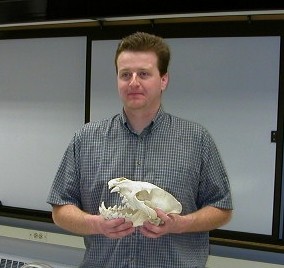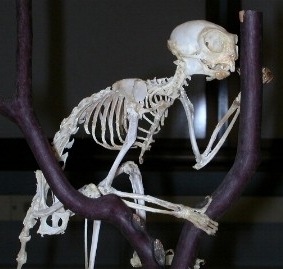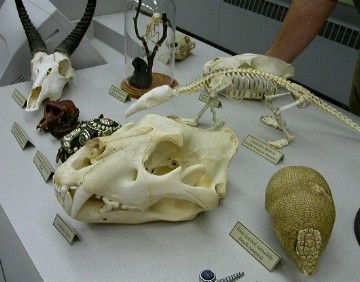2003 - Summer Camp!
2002 - Wings &
Crawly Things
SGAS sponsored a two part "hands-on" program for area kids at the Crawford County, Kansas, "Historical Museum", held June 22nd & 29th, 2002. Various CrawlyThings provided fun and education for those in attendance. The photo, above left, includes all the kids we could manage to assemble after a short field trip; with a grand finale of prizes and a hot-dog feed. Special thanks to Mavis Benner, Liz Mangile and Reggie Smith for putting it together; and to Alicia Kranker for supplying the photos.
 Skull Adaptations of
Mammals
& Birds
Skull Adaptations of
Mammals
& Birds
Joey Williams, of Pittsburg State University's Nature Reach, presented a great program on skulls and bones at the Sperry-Galligar Audubon, March 27, 2003, meeting. Williams pointed out skeletal features that are used to identify animals, their eating habits, and whether or not they were predators. Also how bones are use in forensics to determine how an animal may have met its death. In addition to his excellent power point presentation he had many items, from his personal collection of over 600 specimens, on display. Most fascinating was the complete skeleton of a Pigmy Marmoset (see photo below left). This tiny primate is somewhat unique in that it has claws, not nails, on the ends of its digits. To see a picture of this tiny animal click here. Fortunately, for the science community, Williams' interests begin to change from art to biology when he found his first animal skull. He will soon be leaving PSU to work for the largest skull distribution company in the world, in Oklahoma City. He will be missed.


December 7 & 8, 2001 -- The third annual, Sperry-Galligar Audubon Feed Sale took place on an unseasonably warm, sunshiny week end. Enough can't be said about the dedicated support of our volunteer work force through these two-day bird seed sales. Also, look over these pictures and notice all the wooden products (feeders, houses, etc.), all of which were made by our members. Inside the Pittsburg, Meadowbrook Mall, was a force of sales people taking seed orders. Outside, at the feed truck, "curb service" was in order - filling those orders. Pegg Smith, now deemed the organizations photographer, took these photos to document the event. We appreciate everyone's effort and co-operation that is necessary for our success.
We would like to thank the KAMO Grain for their unwavering support and co-operation; and the Meadowbrook Mall for allowing our feed sale at the Mall.
Dr. Steve Ford,
Vertebrate Zoologist at Pittsburg State University,
presented a program on "Bird Ecology" at the Sperry-Galligar Audubon,
October
26, 2001 meeting. With the aid of a domestic rooster's
skeleton
(far left) Dr. Ford pointed out, to an audience of 60 people,
the
anatomical features that are unique to birds; how they function and the
adaptations
acquired in their evolution. (Photos by Pegg Smith.)